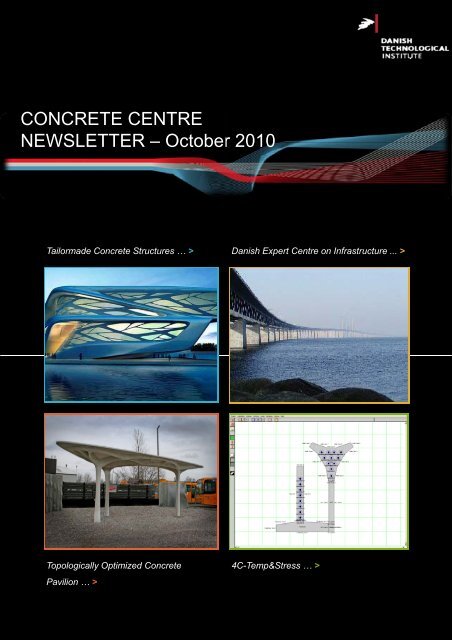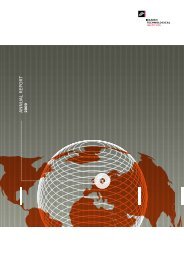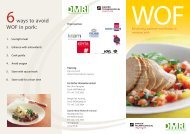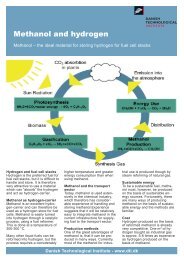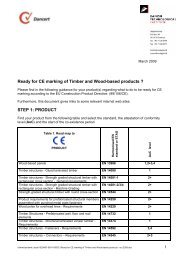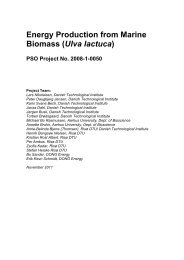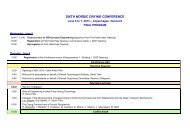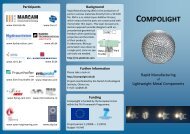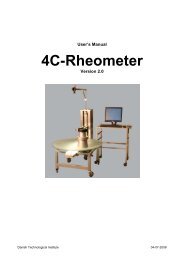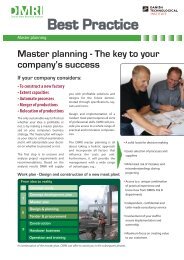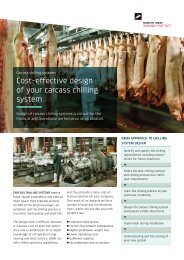Newsletter Concrete Centre October 2010 - Danish Technological ...
Newsletter Concrete Centre October 2010 - Danish Technological ...
Newsletter Concrete Centre October 2010 - Danish Technological ...
You also want an ePaper? Increase the reach of your titles
YUMPU automatically turns print PDFs into web optimized ePapers that Google loves.
CONCRETE CENTRE<br />
NEWSLETTER – <strong>October</strong><br />
<strong>2010</strong><br />
Tailormade <strong>Concrete</strong> Structures … ><br />
<strong>Danish</strong> Expert <strong>Centre</strong> on Infrastructure ... ><br />
Topologically Optimized <strong>Concrete</strong><br />
Pavilion … ><br />
4C-Temp&Stress … >
Tailormade <strong>Concrete</strong> Structures<br />
Introducing and combining robotics and concrete<br />
production allows for the construction of much more<br />
architectural interesting structures because robots<br />
are able to create far more flexible and complex<br />
formwork geometries with very high precision and<br />
reproducibility.<br />
In order to develop and mature this technology, the<br />
TailorCrete project was launched in 2009 and will<br />
run for 5 years. In this project the total value chain<br />
of the concrete industry is represented. The goal of<br />
the project is to industrialize the production of<br />
complex concrete structures while keeping<br />
production costs at an acceptable level. The role as<br />
project manager is taken on by the <strong>Concrete</strong> <strong>Centre</strong><br />
at the <strong>Danish</strong> <strong>Technological</strong> Institute.<br />
Tomorrow’s unique concrete structure.<br />
Displayed is the addition to the Ordrupgaard<br />
museum constructed in 2005.<br />
Read more: www.tailorcrete.com<br />
An example of where these new methods could be<br />
directly applied can be found by looking at the<br />
addition to the Ordrupgaard museum just north of<br />
Copenhagen. This building is constructed of<br />
numerous concrete shells, which have been cast<br />
and joined together on site using self compacting<br />
concrete (SCC) that was dyed black. The casting<br />
process was especially complicated as each shell is<br />
unique and had to fit perfectly with conjoining shells.<br />
To make it even more difficult, all shells are curved<br />
and needed to appear with sharp edges.<br />
For more information please contact:<br />
Dr. Lars Nyholm Thrane<br />
lnth@teknologisk.dk or phone<br />
+45 7220 2215<br />
… ><br />
Exam<br />
mple of expensive manual<br />
construction process, instead<br />
robot<br />
manufactured formwork<br />
could<br />
have been used with<br />
advantages.<br />
Example of standard<br />
industrialised concrete buildings.<br />
Industrial robot cell at the<br />
<strong>Concrete</strong> <strong>Centre</strong>, milling out a<br />
double curved formwork shell<br />
guided by CAM software.
Topologically Optimized <strong>Concrete</strong> Pavilion<br />
The pavilion was cast as a full scale demonstration at the<br />
completion of the national <strong>Danish</strong> research and<br />
development project “Unique <strong>Concrete</strong> Structures”. The<br />
pavilion is situated at the premises of Paschal-Danmark<br />
A/S in Copenhagen, and is believed to be the world’s first<br />
topologically optimized concrete structure.<br />
The pavilion is 12m long, 4.5m wide and 4m high and was<br />
cast using white SCC. Different requirements were<br />
imposed on the flow properties of the columns and<br />
superstructure. SCC with lower filling ability was used for<br />
the superstructure as the finished surface had to have a<br />
slope of up to 3%.<br />
The concrete was produced at a central batch plant using<br />
a 3m 3 counter-current mixer. The transport time to the<br />
construction site was 30 minutes. Only one small truck<br />
load was needed for the casting of the columns, whereas<br />
two normal sized loads were needed for the<br />
superstructure. The casting was performed using a pump<br />
dropping the concrete into the column and superstructure<br />
formwork from above. Control measurements of flow<br />
properties and air content were performed at the<br />
construction site on each delivery.<br />
The topologic optimization is a computer exercise<br />
intended to reduce dimension to a minimum without<br />
affecting the load bearing capacity. The resulting 3D<br />
digital drawings of the pavilion were translated into milling<br />
programs for a 5-axis industrial robot that subsequently<br />
“carved” out the 30 individual pieces of formwork needed<br />
in Expanded Polystyrene (EPS).<br />
The pavilion seen from below.<br />
<strong>Concrete</strong> properties:<br />
• D max : 8mm<br />
• w/c: 0.34<br />
• Air content: 6.5 ±2%<br />
• Target Slump Flow superstructure: 550 ±30mm<br />
• Target Slump Flow columns: 630 ±30mm<br />
• Plastic viscosity: 100-200 Pa·s (4C-Rheometer)<br />
• Compressive strength: 55-60 MPa at 28 days maturity<br />
For more information please contact:<br />
Thomas Juul Andersen<br />
tja@teknologisk.dk or phone<br />
+45 7220 2157<br />
… ><br />
Example of topologic optimization, which<br />
shows the stress distribution in a structure.
<strong>Danish</strong> Expert <strong>Centre</strong> on Infrastructure<br />
The <strong>Concrete</strong> <strong>Centre</strong> has a strategic focus on<br />
infrastructure and together with the Technical University of<br />
Denmark (DTU) a new expert centre on infrastucture has<br />
been formed based on a 3 year performance contract<br />
starting ultimo <strong>2010</strong>. The primary focus area of the centre<br />
will be durability of reinforced concrete structures in harsh<br />
environments, e.g. tunnels, bridges, quays.<br />
The expert centre will combine complementary<br />
competences and laboratory facilities at the two<br />
knowledge centers. As an example the <strong>Concrete</strong> <strong>Centre</strong><br />
has a brand new hightech concrete laboratory for<br />
batching, mixing and casting concrete, i.e. handling fresh<br />
concrete, while DTU has advanced equipment and<br />
knowledge within crack formation and statics, i.e.<br />
hardened concrete properties.<br />
Microscopy evaluation of crack formation.<br />
The expert centre is expected to provide a considerable<br />
contribution to the efforts of using infrastructure<br />
improvements to create growth in the construction industry<br />
in the coming decade.<br />
The following research areas will be covered by the<br />
centre:<br />
• long time durability evaluation using micro and macro<br />
analysis of existing bridges in seawater.<br />
• contribution to models for chloride transport and<br />
binding.<br />
• influence of micro defects on durability.<br />
• influence of chloride concentration values on corrosion<br />
initiation and corrosion rate in different exposure<br />
environments.<br />
• models for crack formation caused by corrosion.<br />
• influence of casting defects on durability.<br />
• influence of rheology and casting method on durability.<br />
• development of models for prediction of service-life.<br />
For more information please contact:<br />
Setup for controlled crack formation in concrete block.<br />
Both path and width of crack are controlled.<br />
Mette Glavind<br />
meg@teknologisk.dk or phone<br />
+45 7220 2220<br />
… ><br />
Highway bridge in Western Denmark cast using only<br />
self compacting concrete.
4C-Temp&Stress<br />
The <strong>Concrete</strong> <strong>Centre</strong> offers assistance within hardening<br />
technology in form of training of engineers and<br />
documentation/simulation of the hardening process in<br />
concrete structures. The simulation is done using 4C-<br />
Temp&Stress, which is a computational tool to calculate<br />
temperatures and stresses in hardening concrete<br />
structures.<br />
By means of 4C-Temp&Stress the hardening period can<br />
be simulated on a pc in order to avoid or minimize earlyage<br />
thermal cracking during the first few days after<br />
casting. The parameters affecting early-age cracking are<br />
the casting rate, formwork, ork insulation, cooling pipes,<br />
heating wires, ambient weather conditions, etc.<br />
The results of a calculation may be presented as:<br />
• diagrams showing temperature, maturity, strength and<br />
stress as functions of time.<br />
• isocurves of temperature, maturity, strength and stress<br />
at a given time.<br />
Example of structure drawn in 4C-Temp&Stress.<br />
Since the mid-1990s 4C-Temp&Stress has been used to<br />
document curing and early-age requirements on several<br />
large civil structures around the world, including:<br />
• The Øresund Link between Copenhagen and Sweden.<br />
•Copenhagen Minimetro, bored tunnels and deep<br />
stations.<br />
• Malmø Citytunnel, Sweden.<br />
• Marmaray Railway crossing, Istanbul, Bosphorus<br />
Strait, bored tunnel, cut and cover, deep stations,<br />
Gama-Nurol JV.<br />
• Sitra bridges, Bahrain, Gamuda Berhad Contractors.<br />
• Funder highway bridge, Denmark, Züblin-Dyvidag JV.<br />
For more information please contact:<br />
Jens Ole Frederiksen<br />
jlf@teknologisk.dk or phone<br />
+45 7220 2218<br />
Diagram showing temperature as function of time<br />
in different parts of the structure.<br />
… ><br />
Temperature isocurves in the structure at a given time.


